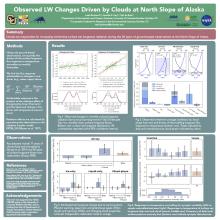Clouds drive the wintertime surface energy budget response to temperature variations at a long-term Arctic observatory
Leah
Bertrand
CU/CIRES
Poster
Wintertime radiative cooling at the Arctic surface impacts surface temperatures and sea ice. Cooling is highly dependent on clouds and is controlled by the balance between opaque and semitransparent surface-atmospheric states. Since the Arctic cloud response to warming is uncertain, it is unknown whether surface radiative cooling with strengthen or weaken with global warming, as well as how the balance of surface-atmospheric states will change. Here, we use multiple decades of measurements from an Arctic observatory with significant recent warming in order to understand the cloud and surface radiative response to monthly temperature variability during winter. We find a reduction in surface radiative cooling during warmer months due a greater radiative response aloft than at the surface and from a more frequently opaque atmosphere. To understand this result, we quantify drivers of the response with idealized radiative transfer calculations. We find that temperature and moisture changes alone are insufficient to explain the observed reduction in cooling, and that cloud changes are needed to match the sign of the observed total response. Cloud increases are driven more frequent ice clouds with increase ice water paths. More broadly, this study suggests that changing cloud properties may trap more energy at the surface as the Arctic warms.

Bertrand-Leah-poster.pdf
(4.52 MB)
Meeting homepage
